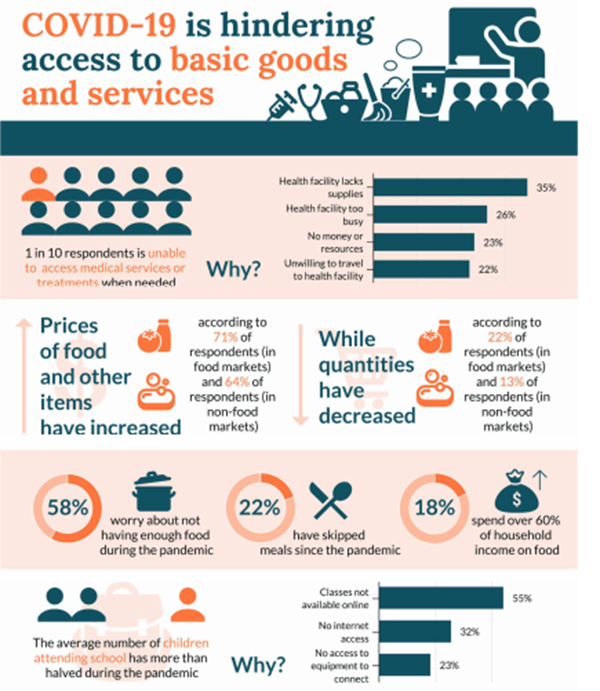Up to the end of last year, research had found that as a result of COVID-19 prices of food and other items in Guyana had increased while the available quantities have decreased. The first quarter of 2021 has seen this trend continue as the pandemic’s impact on production and shipping prices becomes more pronounced, according to April reports from Food and Agriculture Organisation (FAO) and the United Nations Conference on Trade and Development (UNTAD).
“Most noticeable among the effects is that for both food and non-food markets, prices were increased. Approximately 70.8% and 63.7% of the respondents said this about food markets and non-food markets respectively. Next in line is a decrease in the quantity of the products which was cited by 21.5% and 13.3% for food and non-food items respectively. The third observation is that approximately 15.1% and 13.2% respectively of the respondents indicated that some food and non-food items are no longer available altogether,” a December 31,2020 United Nations Development Fund (UNDP) report, titled Socio-Economic Impact Assessment of COVID-19 on Households in Guyana, stated.
The report resulted from a survey conducted by The Consultancy Group (TCG), which sought to provide data so that evidence-based response and recovery measures can be crafted and implemented.
It is not clear if the report has been accessed by policymakers but retailers and customers alike have recently raised complaints about the increasing costs of food items.
“Over the last four months a lot of prices have increased by 10% to 40%. It started with oil and butter but now it’s everything. Milk, flour, rice, cereals, all dry goods have seen a significant increase in prices,” a Sophia shopkeeper told Stabroek News.
He explained that even sugar, which is not imported, had a significant increase in price for the large bag while the smaller packages have seen a smaller increase in cost.
“The big bag went from six thousand something to eight thousand something, almost nine. The smaller pack one had a small increase but GuySuCo doing more distribution directly so it’s not like you gotta buy from a wholesaler. Due to the fact that they cut that middle man out is just about the same price but the bigger bag they increase the price,” it was pointed out.
Vendors at the Bourda market have similar complaints about imported fruits.
“What I selling for is what I buy it for. They say the container dey pon the wharf more than four weeks and well, a box of 150 apples selling now for $15,000. It used to be $10,500 or sometimes $12,000 but now it’s $15,000 or $16,000 and grape is the same thing. But what? you gotta take it because customers looking for the product yet you not making money,” the vendor noted.
These increases are however not unique to Guyana. According to the FAO’s world food index, global prices have increased for an 11th consecutive month in April, hitting their highest level since May 2014.
The index, which measures monthly changes for a basket of cereals, oilseeds, dairy products, meat and sugar, averaged 120.9 points last month versus a revised 118.9 in March. It was 30.8 % higher than its level in the same month last year.
According to the organisation, worries about crop conditions in Argentina, Brazil, and the United States, pushed maize prices up 5.7% last month, while wheat prices held largely steady. The vegetable oil price index rose 1.8% as international palm oil quotations rose on concerns that production growth in major exporting countries would be slower than expected. Soy and rapeseed oil values also climbed further, while sunflower oil prices contracted moderately.
Dairy prices rose 1.2%, with butter, skim milk powder, and cheese all lifted by solid demand from Asia, while the meat index climbed 1.7%.
These increases in the price for food products is compounded by increases in shipping costs.
UNTAD has explained that due to a variety of reasons freight rates surged during the pandemic.
“Container freight rates have reached historical highs, and rates to South America and West Africa are now higher than to any other major trade region. The obstruction of the Suez Canal by a grounded container ship contributed to a recent further surge in freight rates,” UNTAD’s April policy brief explained.
Currently, rates to South America and western Africa are higher than to any other major trade region. By early 2021, for example, freight rates from China to South America had jumped 443% compared with 63% on the route between Asia and North America’s eastern coast.
The brief goes on to explain that while the underlying causes are complex they include capacity management by carriers and a severe shortage of containers as these are held up in waiting ships.
“Combined with pandemic-related delays in intermodal connections. The impact of the container shortage is greater on longer and thinner trade routes to developing regions than on the main East-West routes,” it adds.
The fact is that routes from China to countries in South America such as Guyana are often longer. More ships are required for weekly service on these routes, meaning many containers are also “stuck” on these routes.
“When empty containers are scarce, an importer in Brazil or Nigeria must pay not only for the transport of the full import container but also for the inventory holding cost of the empty container,” the policy brief informed.
Another factor is the lack of return cargo. South American and western African nations import more manufactured goods than they export, and it’s costly for carriers to return empty boxes to China on long routes.
The brief notes that the current surge is expected to last into 2021 and policy makers therefore need to focus on further reforms in trade facilitation and ports; improved tracking and forecasting; and strengthening national competition authorities.






